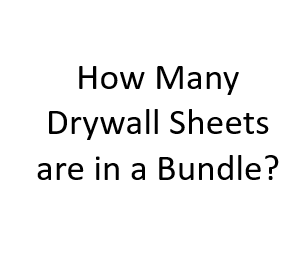When it comes to home construction or renovation projects, understanding the materials you’re working with is essential. Drywall, also known as plasterboard or gypsum board, is a fundamental component in modern construction. It’s used to create smooth, durable walls and ceilings, providing a blank canvas for further interior design. One common question that arises during drywall projects is: How many sheets are in a bundle? In this blog post, we’ll delve into the world of drywall and unravel the mystery behind bundle quantities.
The Basics of Drywall
Before we dive into the specifics of bundle quantities, let’s take a quick look at what drywall is and why it’s an integral part of construction.
Drywall is composed of gypsum plaster sandwiched between two layers of paper. This composition gives it fire-resistant, sound-dampening, and insulating properties, making it an excellent choice for interior walls and ceilings. Drywall comes in various thicknesses, with the most common being 1/2 inch and 5/8 inch. Thicker drywall is often used for areas where additional strength or fire resistance is required, such as in garages or near stoves.
Understanding Bundle Quantities
Now, let’s address the main question: How many sheets are typically in a bundle of drywall? The answer can vary depending on the size and thickness of the sheets, as well as regional practices. However, a standard bundle usually contains around 70 to 75 sheets of 4×8-foot drywall.
It’s important to note that larger sheets, such as 4×12 feet, are also available. These larger sheets are commonly used in commercial construction to cover larger surface areas quickly and efficiently. Bundles of 4×12-foot drywall typically contain around 50 to 55 sheets.
Why Bundle Quantities Matter
Understanding bundle quantities is crucial for several reasons:
- Project Planning: Knowing how many sheets are in a bundle helps you estimate the amount of drywall needed for your project accurately. This prevents you from overestimating or underestimating the required quantity, saving you time and money.
- Transportation and Handling: Bundles of drywall are heavy and bulky. Knowing the number of sheets in a bundle helps you plan for transportation and ensure you have the necessary manpower or equipment to move and handle the drywall safely.
- Cost Estimation: Bundles are often sold at a discounted rate compared to buying individual sheets. Being aware of the number of sheets in a bundle allows you to calculate the cost of materials more precisely.
Tips for Working with Drywall
Working with drywall requires attention to detail and proper techniques. Here are a few tips to keep in mind:
- Measure Twice, Cut Once: Accurate measurements are essential to minimize waste and ensure a seamless finish. Always double-check your measurements before making cuts.
- Use the Right Tools: Invest in quality tools designed for cutting and installing drywall. A utility knife, T-square, and drywall saw are essential for clean and precise cuts.
- Secure Properly: When installing drywall, make sure to use appropriate fasteners, such as drywall screws, and follow recommended spacing guidelines to prevent sagging or cracking over time.
- Joint Compound Application: Properly apply joint compound and tape to cover seams and screw indentations. Sand the compound smooth for a seamless finish before painting.
Calculating Bundle Quantities Based on Project Size
Now that we’ve covered the basics of bundle quantities, let’s delve deeper into how to calculate the number of bundles you’ll need for your specific project. This step is crucial for effective project management and cost estimation.
- Measure the Space: Start by measuring the area where you’ll be installing drywall. For walls, measure the height and length of each wall. For ceilings, measure the length and width of each ceiling surface.
- Account for Doors and Windows: Deduct the square footage of doors and windows from your measurements. This will give you a more accurate estimate of the drywall needed for the actual surfaces.
- Calculate Surface Area: Multiply the length and height of each wall and ceiling surface to calculate the square footage. Add up the square footage of all surfaces to determine the total area.
- Account for Waste: It’s recommended to add a percentage (usually around 10%) to account for waste due to cutting, mistakes, and irregularities in the space.
- Determine Sheet Requirements: Divide the total square footage by the square footage of a single sheet of drywall. This will give you the approximate number of sheets needed for your project.
- Estimate Bundles: Divide the number of sheets by the average number of sheets in a bundle to determine how many bundles you’ll need. Remember that bundles are typically sold in whole numbers, so round up to ensure you have enough materials.
- Consider Extra Sheets: It’s a good practice to purchase a few extra sheets beyond your calculated quantity. This ensures you have replacements in case of damage during installation or future repairs.
- Thickness Matters: If you’re using thicker drywall, the weight of the sheets per bundle may be slightly different. Be sure to adjust your calculations accordingly.
Conclusion
As a blog post writer, understanding the intricacies of drywall and its bundle quantities adds a valuable layer of knowledge to your expertise. The world of construction materials can be complex, but by providing clear explanations and practical tips in your blog posts, you empower your readers to confidently tackle their own projects. From unraveling the mystery of bundle quantities to offering step-by-step guides on installation techniques, your blog can become a go-to resource for DIY enthusiasts, homeowners, and professionals alike.
By arming your readers with the knowledge they need to approach drywall projects with confidence, you contribute to the success of their endeavors and help them transform their spaces into beautifully finished areas. Remember, your blog posts should be at least 800 words, allowing you to delve even deeper into the nuances of drywall and provide comprehensive information that truly adds value to your readers’ experiences.

